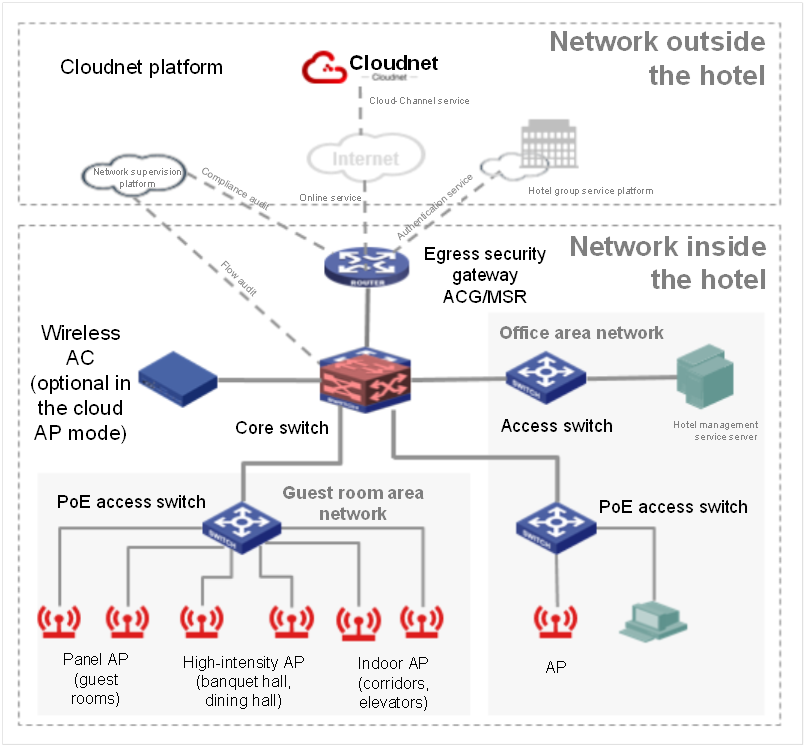H3C Smart Hotel Wireless Solution
1. Demands
After more than a decade of rapid development, the hospitality industry has ushered in new challenges:
When the hotel management groups transform to chain stores, they need to invest a lot for network management, O&M and manpower expenses. The total cost of ownership (TCO) remains high.
Hotels are too dependent on OTA platforms for customer acquisition and urgently need to develop direct sales channels to increase profitability, improve user experience, and enhance brand satisfaction.
Nearly 300 prefecture-level cities across the country have significantly different network supervisory platforms, with high compliance requirements.
Accordingly, customers of hotel management groups need a new network construction and O&M model. As the new architecture of network cloud can be a useful solution to the problems of the traditional network, it has been accepted by more and more customers.
The current problems in the construction of smart hotels are as follows:
1. Unreasonable wireless deployment results in slow network connection speed. Low usage of the wireless network at hotels is the main point of complaints by customers.
2. Complicated network device deployment results in long deployment period and difficult maintenance. It also requires a great deal of manpower and finance input.
3. Weak security protection results in unsecured hotel network security. It is difficult to meet the non-operating demands.
4. The wireless networks of traditional hotels do not have marketing functions, and wireless inputs cannot create business values.
2. H3C smart hotel wireless solution design

The H3C smart hotel wireless solution is a new generation network solution for customers of the chain hotel management groups. It provides customers with simple network O&M and enhanced value-added services based on the powerful support capability of the Cloudnet public cloud platform, with the characteristics of "cloud management, simple deployment, easy O&M, general security, complete wireless, and extended direct-sales".
The solution covers the network in the hotel, and provides the Cloudnet cloud management platform to incorporate the hotel network and security devices. The hotel network adopts a typical two-layer architecture (access layer and core layer). There are four types of devices in the architecture which includes the AP, switch, AC and egress gateway from bottom up. Cloudnet can provide the common visualized O&M configuration for the above four types of devices.
3. Advantages
Wireless scenarios with full coverage
Through the scenario-based professional AP deployment, the hotel wireless network achieves full coverage. The hotel rooms use panel-type APs to provide wireless coverage in the rooms directly, avoiding the problem of poor signal and unavailable network in the rooms caused by the wireless signal penetrating the room walls or even the bathroom when the ceiling APs are deployed in the corridors of the building. For scenarios with demands of high density, such as lobbies and conference rooms, dedicated high-intensity APs are deployed, and their excellent performance such as high throughput and high user concurrency can well meet the demand for wireless access. Since the outdoor environment is harsh, outdoor APs must be waterproof and lightning proof with high protection capability, to realize outdoor long-distance and large-capacity access and to ensure the stability and reliability of the whole wireless system.
Centralized incorporation to streamline the process
The hotel-wide network topology is visible. What you see is what you get. The topology view-based device management wizard, which displays the topology of device link connections for registered devices and provides a variety of functions, helps administrators manage devices in the network.
Hierarchical and rights-based management is applicable to the headquarters and branch management model and suitable for chain hotel business scenarios.
Two powerful tools, USB disk deployment and cloud template deployment are provided, to reduce the complexity and workload of on-site deployment and improve the efficiency.
Automatic and efficient acceptance with one click is supported. After deployment, the wireless network acceptance report is automatically generated with one click. The report includes a device list, acceptance summary, device operation status report, acceptance test report, in-depth business analysis report, off-line device list, etc.
Agile O&M, free from worry
The card-layout room O&M interface is consistent with what the staff in the hospitality industry prefer. The room labels can be customized. Card-layout room management is supported. What you see is what you get. The front-desk receptionists can restart the faulty wireless APs in rooms with one click, without any requirement on IT capabilities.
Mobile O&M through the Cloudnet app enables monitoring and evaluation of the network health from devices, alarms, security, terminals and APs. Cloudnet app can also provide 15 tests to all devices in the network from dimensions of configuration, operational status, and service.
Digital marketing, straight to customers
Multi-channel access authentication: According to relevant national laws and regulations, the real-name authentication is required when customers use the public network services in the hotel. The solution supports authentication via SMS and membership, and it covers both wired and wireless network access scenarios in hotels:
Digital marketing: Cloudnet provides universal membership system docking function, which enables docking with customers' membership system by graphical configuration on the side of Cloudnet. Membership authentication can help hotels develop their own members, expand direct sales channels, reduce their dependence on OTA platforms, and improve their profitability. In addition, customized ads can be added to the pushed authentication page to help hotels promote value-added services.
Non-operating docking, compliance and trouble-free
Both MSR and ACG in the solution support docking with the network supervision platform of each prefecture-level city in China. Currently they have compliance landing cases in more than 200 prefecture-level cities in China, with the industry's well-known non-operating docking capability.


